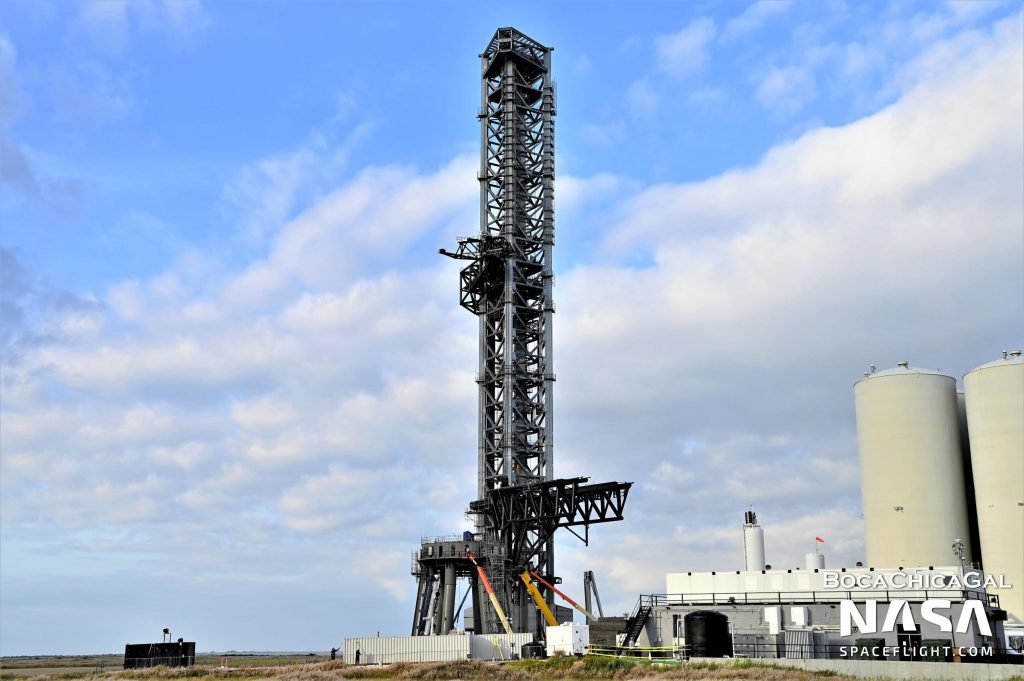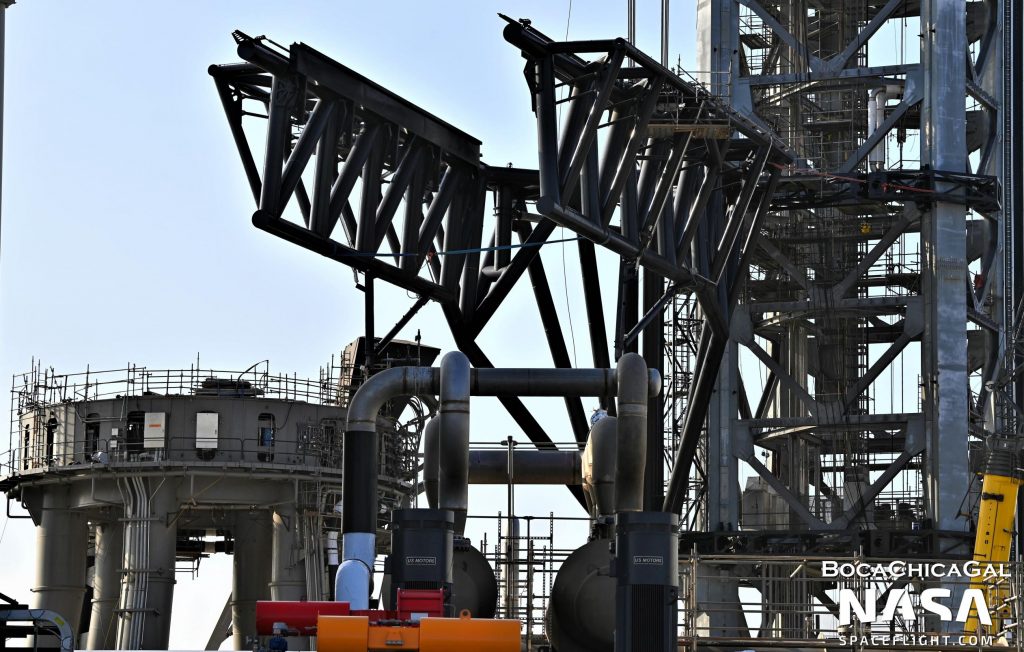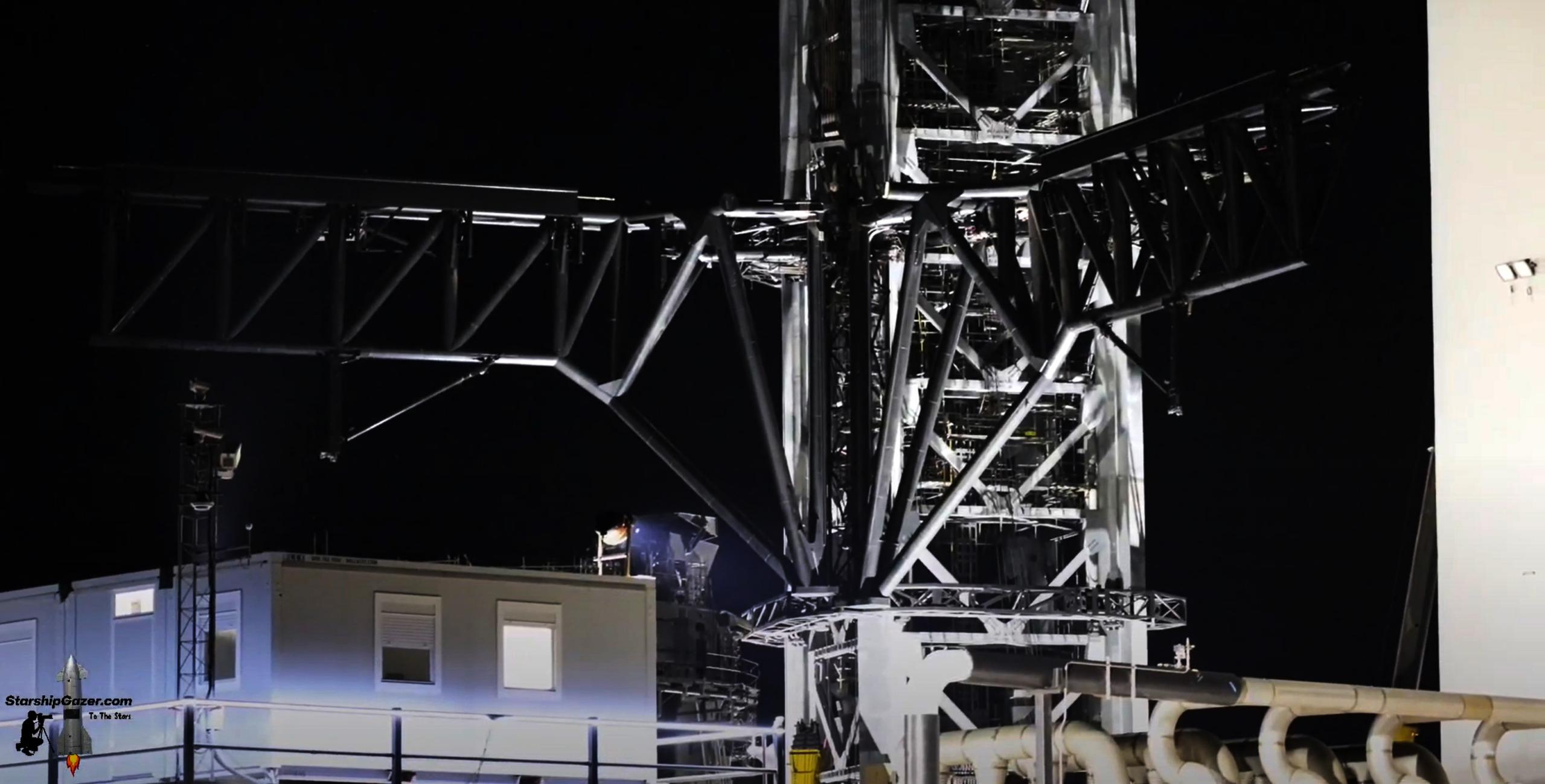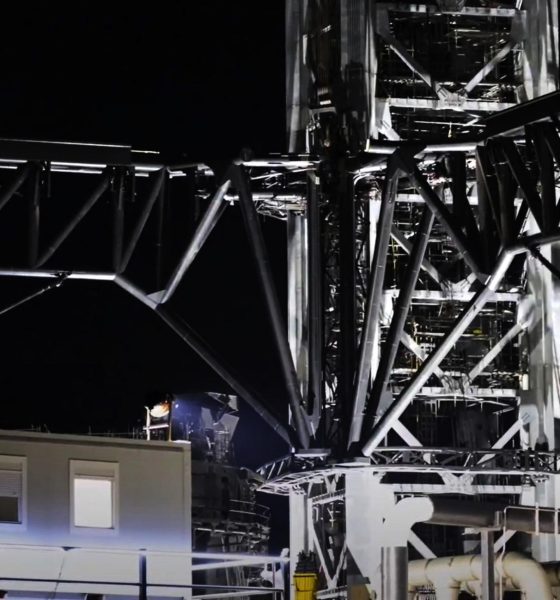Update: Shortly after publishing, SpaceX began a much more ambitious series of tests with the Starship launch tower’s two main arms, which are designed to lift and (one day) catch Starships and Super Heavy boosters.
After lifting the arm carriage about 15m (~50 ft), several times higher than January 3rd’s far more conservative kickoff, SpaceX fired up each arm’s main hydraulic actuator and opened them about as wide as they’re able to move. Unsurprisingly, the arms’ first powered lateral movement happened very slowly, obviously telegraphing caution but probably also hinting at the start of a calibration process needed to determine their full range of motion and associate those positions with certain sensor readings or telemetry to ensure they can be safely controlled. As of midnight CST, that testing has continued well into the night.
Regardless of the purpose, substantial powered movement is a major milestone for the tower’s main arms and all but guarantees that more extensive tests and simulations are soon to come.
SpaceX has moved Starbase’s rocket-catching “chopstick” arms for the first time since they were installed on the orbital Starship pad’s ‘launch tower’ two months ago.
After a shockingly brisk three-month period of assembly, the first arm installed in late August 2021 was a lone structure designed to swing in; grab and stabilize Super Heavy with its claw; fuel and power Starship; and quickly detach and swing away from the rocket during launch. A month and a half later, SpaceX begin installing a much larger pair of more complex arms in mid-October. Unlike the Starship quick-disconnect (QD) arm, the pair of arms that followed were almost nothing like anything built as part of another rocket launch complex.
Unlike other ‘arms’ related to other rocket launch facilities, the pair SpaceX began to install on Starbase’s launch tower were colossal, measuring more than 30m (100+ ft) long and 5-10m (15-30 ft) tall. Built out of heavy-duty steel pipe and affixed to an even sturdier pair of claw-like supports that grab onto the launch tower, the combined assembly likely weighs hundreds of tons. Aside from their sheer scale, Starbase’s main tower arms are also attached to a complex system of cables and an industrial-strength ‘drawworks’ commonly used on giant oil rigs and derricks.
They also feature huge actuators that allow the two arms to open and close, revealing a bit of their purpose. While the main reason they likely exist is to provide SpaceX with an all-weather alternative to cranes for lifting, manipulating, and precisely stacking Starships and Super Heavy boosters at the launch pad, the headline – ever since Musk revealed the idea – has always been plans to use those same arms to literally catch rockets out of mid-air.
To do so, they’ll need to be able to actuate and move extremely quickly and precisely up and down the Starship launch tower, matching the velocity and autonomously determining the position of landing Super Heavy boosters (and possibly Starships) to avoid major damage or the loss of entire vehicles. While arguably an unnecessary gamble and an attempt to micro-optimize the concept of operations of a rocket that’s yet to attempt a single orbital-class launch, SpaceX’s CEO is clearly committed to the idea and – whether or not the first iteration works – has fully delivered on the first complete lift-and-catch system.


On January 3rd, 2022, after removing a large amount of scaffolding in the days prior, SpaceX briefly and slightly moved the installed arms for the first time, using the drawworks to lift the entire arm-and-carriage assembly a few meters (~6 ft) up and down the tower. Once a few minor additional steps are taken, the chopsticks could be ready for much more extensive testing, beginning with basic lift, descent, and arm actuation tests to calibrate and then proof the first-of-its-kind mechanism. Later, SpaceX will likely simulate catching rockets in a wide range of scenarios. Somewhere before, during, or after that testing, SpaceX may perform another fit test with Starship S20 and Super Heavy B4 – but this time using the arms to lift and install the stages.

Elon Musk
Elon Musk’s Biggest Revelations on AI, Robots, and the Future of Work from the Moonshots Podcast

Elon Musk’s appearance on the Moonshots with Peter Diamandis podcast was packed with bold predictions, candid admissions, and surprising tech insights. The nearly three-hour conversation covered everything from artificial intelligence to humanoid robots, geopolitics, and the future of work. Here are the top 10 most intriguing takeaways:
-
Aggressive AGI Timeline Predictions
Musk offered a detailed view on when artificial general intelligence (AGI) could emerge, suggesting it may arrive sooner than many expect, emphasizing both transformative potential and risks.
-
U.S. vs. China in the AI Race
He discussed the strategic competition between the United States and China over AI development, noting that geopolitical dynamics will shape how and who leads in the next decades.
-
Future of Job Markets
Musk touched on how AI and automation could reshape employment, predicting massive boosts in productivity alongside potential disruptions in traditional work structures.
-
Clean Energy Transition
A recurring theme was the role of clean energy in future economies, with Musk reiterating the importance of scaling sustainable power generation and storage.
-
Humanoid Robots Are Coming
On the podcast, Musk elaborated on Tesla’s work on humanoid robots, hinting at timelines and applications that go beyond factories to general-purpose assistance.
-
Tesla Roadster “Last Human-Driven Car”
Outside the core discussion topics, Musk teased features of the upcoming Tesla Roadster — calling it “the best of the last of the human-driven cars” and suggesting safety won’t be its main selling point.
-
The Role of AI in Clean Energy and Robotics
Linking AI to both energy optimization and robotics, Musk explained how smarter systems could accelerate decarbonization and task automation across industries.
-
U.S. Innovation Leadership
Musk argued that maintaining American leadership in key tech sectors like AI, space, and robotics should be a national priority, with thoughtful policy and investment.
-
Job Creation vs. Job Elimination
While acknowledging automation’s disruptive effects, he also outlined scenarios where new industries and opportunities could emerge, particularly in AI, space, and advanced manufacturing.
-
Long-Term Vision for Humanity
Throughout the conversation, Musk revisited his long-term philosophical views — including a belief in humanity’s responsibility to become a multi-planetary and technologically empowered species.
Whether you agree with Musk’s optimism or not, the podcast offers a window into the thinking of one of the most influential figures in tech today, in and why his visions continue to spark debate and inspiration.
Elon Musk
Starlink achieves major milestones in 2025 progress report
Starlink wrapped up 2025 with impressive growth, adding more than 4.6 million new active customers and expanding service to 35 additional countries, territories, and markets.

Starlink wrapped up 2025 with impressive growth, adding more than 4.6 million new active customers and expanding service to 35 additional countries, territories, and markets. The company also completed deployment of its first-generation Direct to Cell constellation, launching over 650 satellites in just 18 months to enable cellular connectivity.
SpaceX highlighted Starlink’s impressive 2025 progress in an extensive report.
Key achievements from Starlink’s 2025 Progress
Starlink connected over 4.6 million new customers with high-speed internet while bringing service to 35 more regions worldwide in 2025. Starlink is now connecting 9.2 million people worldwide. The service achieved this just weeks after hitting its 8 million customer milestone.
Starlink is now available in 155 markets, including areas that are unreachable by traditional ISPs. As per SpaceX, Starlink has also provided over 21 million airline passengers and 20 million cruise passengers with reliable high-speed internet connectivity during their travels.
Starlink Direct to Cell
Starlink’s Direct to Cell constellation, more than 650 satellites strong, has already connected over 12 million people at least once, marking a breakthrough in global mobile coverage.
Starlink Direct to Cell is currently rolled out to 22 countries and 6 continents, with over 6 million monthly customers. Starlink Direct to Cell also has 27 MNO partners to date.
“This year, SpaceX completed deployment of the first generation of the Starlink Direct to Cell constellation, with more than 650 satellites launched to low-Earth orbit in just 18 months. Starlink Direct to Cell has connected more than 12 million people, and counting, at least once, providing life-saving connectivity when people need it most,” SpaceX wrote.
Elon Musk
Starlink passes 9 million active customers just weeks after hitting 8 million
The milestone highlights the accelerating growth of Starlink, which has now been adding over 20,000 new users per day.

SpaceX’s Starlink satellite internet service has continued its rapid global expansion, surpassing 9 million active customers just weeks after crossing the 8 million mark.
The milestone highlights the accelerating growth of Starlink, which has now been adding over 20,000 new users per day.
9 million customers
In a post on X, SpaceX stated that Starlink now serves over 9 million active users across 155 countries, territories, and markets. The company reached 8 million customers in early November, meaning it added roughly 1 million subscribers in under seven weeks, or about 21,275 new users on average per day.
“Starlink is connecting more than 9M active customers with high-speed internet across 155 countries, territories, and many other markets,” Starlink wrote in a post on its official X account. SpaceX President Gwynne Shotwell also celebrated the milestone on X. “A huge thank you to all of our customers and congrats to the Starlink team for such an incredible product,” she wrote.
That growth rate reflects both rising demand for broadband in underserved regions and Starlink’s expanding satellite constellation, which now includes more than 9,000 low-Earth-orbit satellites designed to deliver high-speed, low-latency internet worldwide.
Starlink’s momentum
Starlink’s momentum has been building up. SpaceX reported 4.6 million Starlink customers in December 2024, followed by 7 million by August 2025, and 8 million customers in November. Independent data also suggests Starlink usage is rising sharply, with Cloudflare reporting that global web traffic from Starlink users more than doubled in 2025, as noted in an Insider report.
Starlink’s momentum is increasingly tied to SpaceX’s broader financial outlook. Elon Musk has said the satellite network is “by far” the company’s largest revenue driver, and reports suggest SpaceX may be positioning itself for an initial public offering as soon as next year, with valuations estimated as high as $1.5 trillion. Musk has also suggested in the past that Starlink could have its own IPO in the future.










